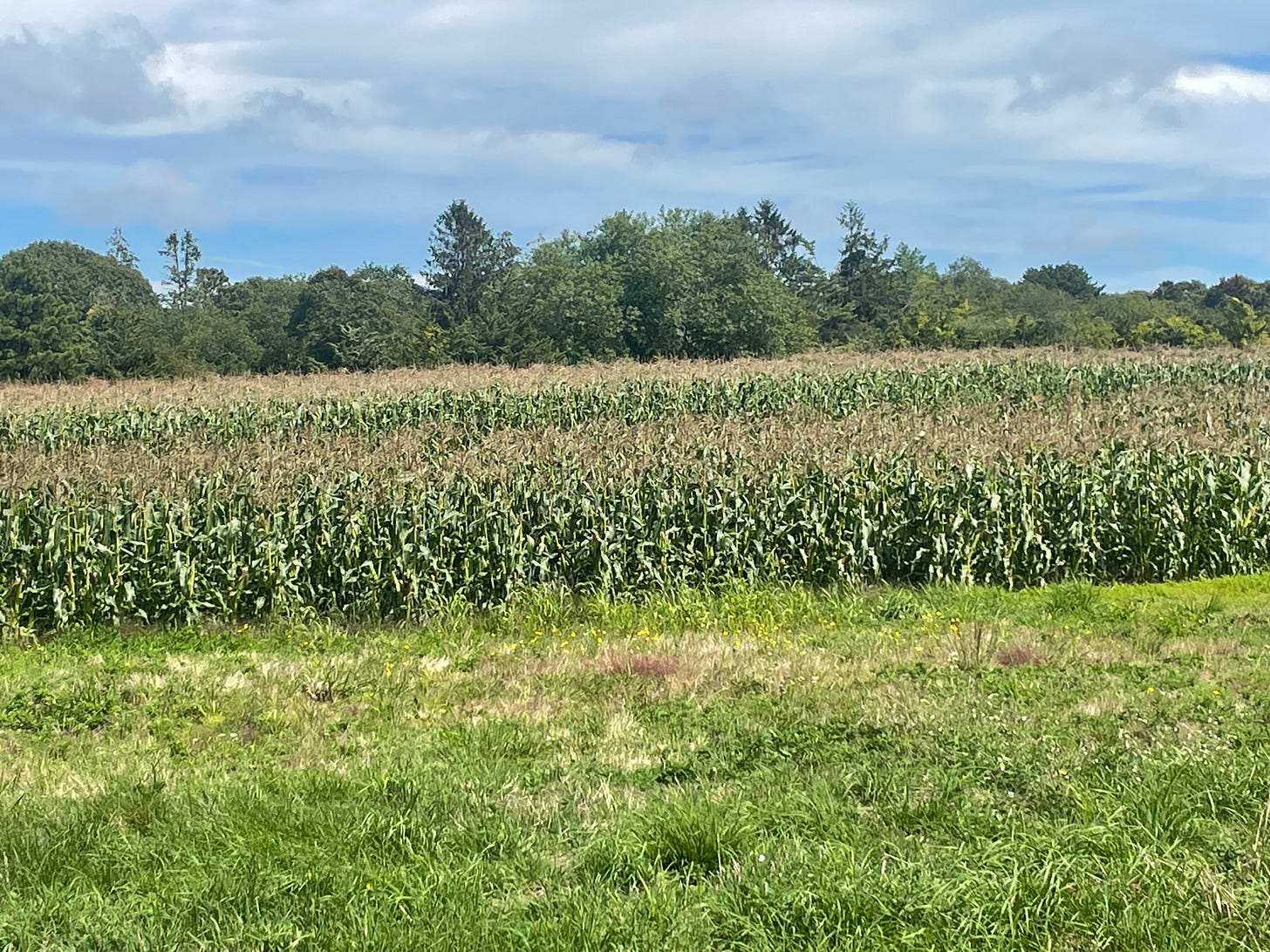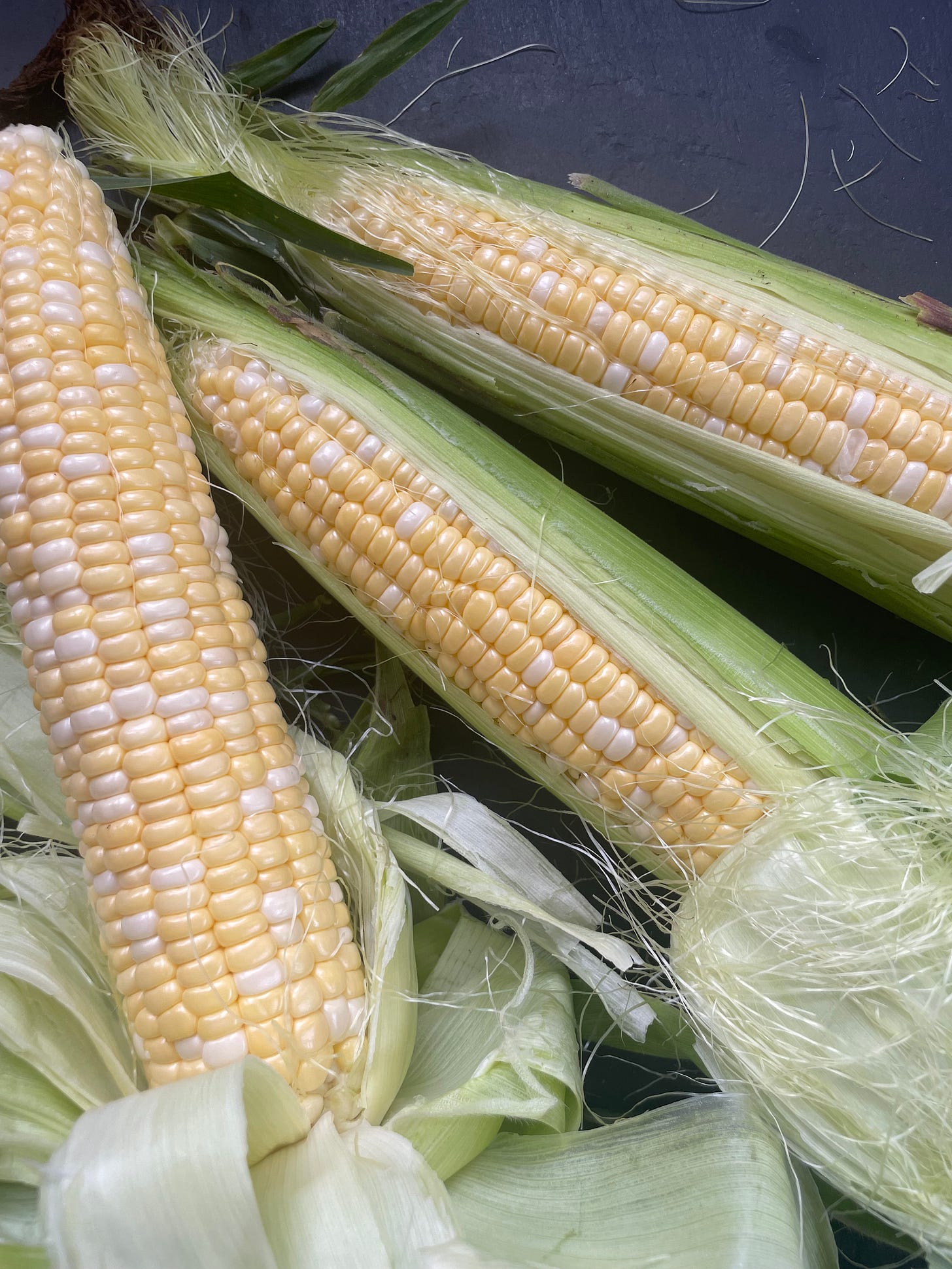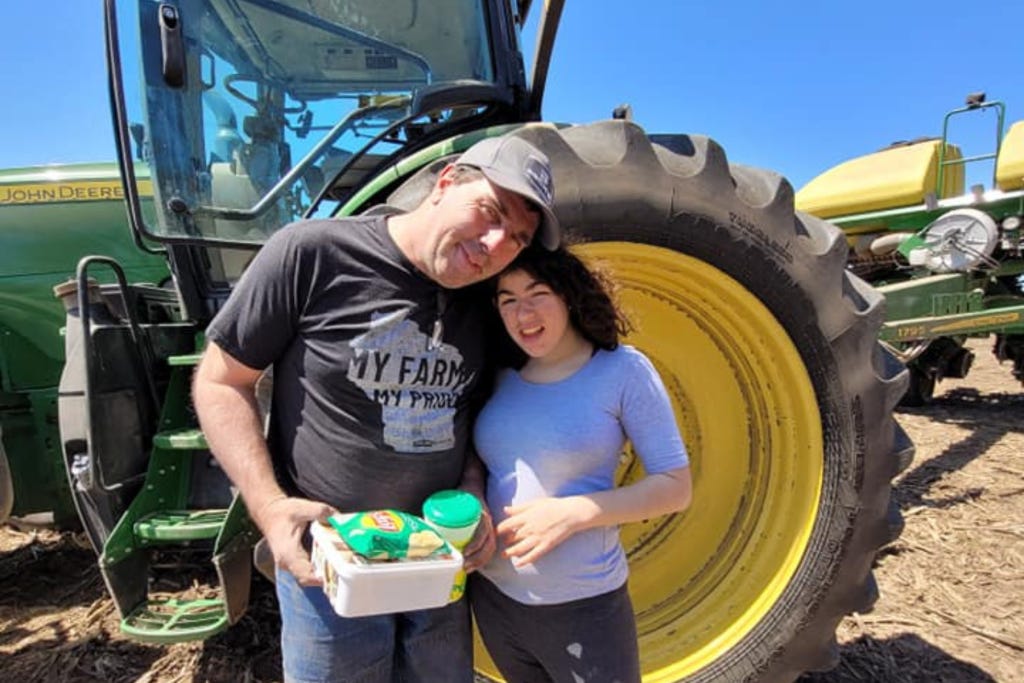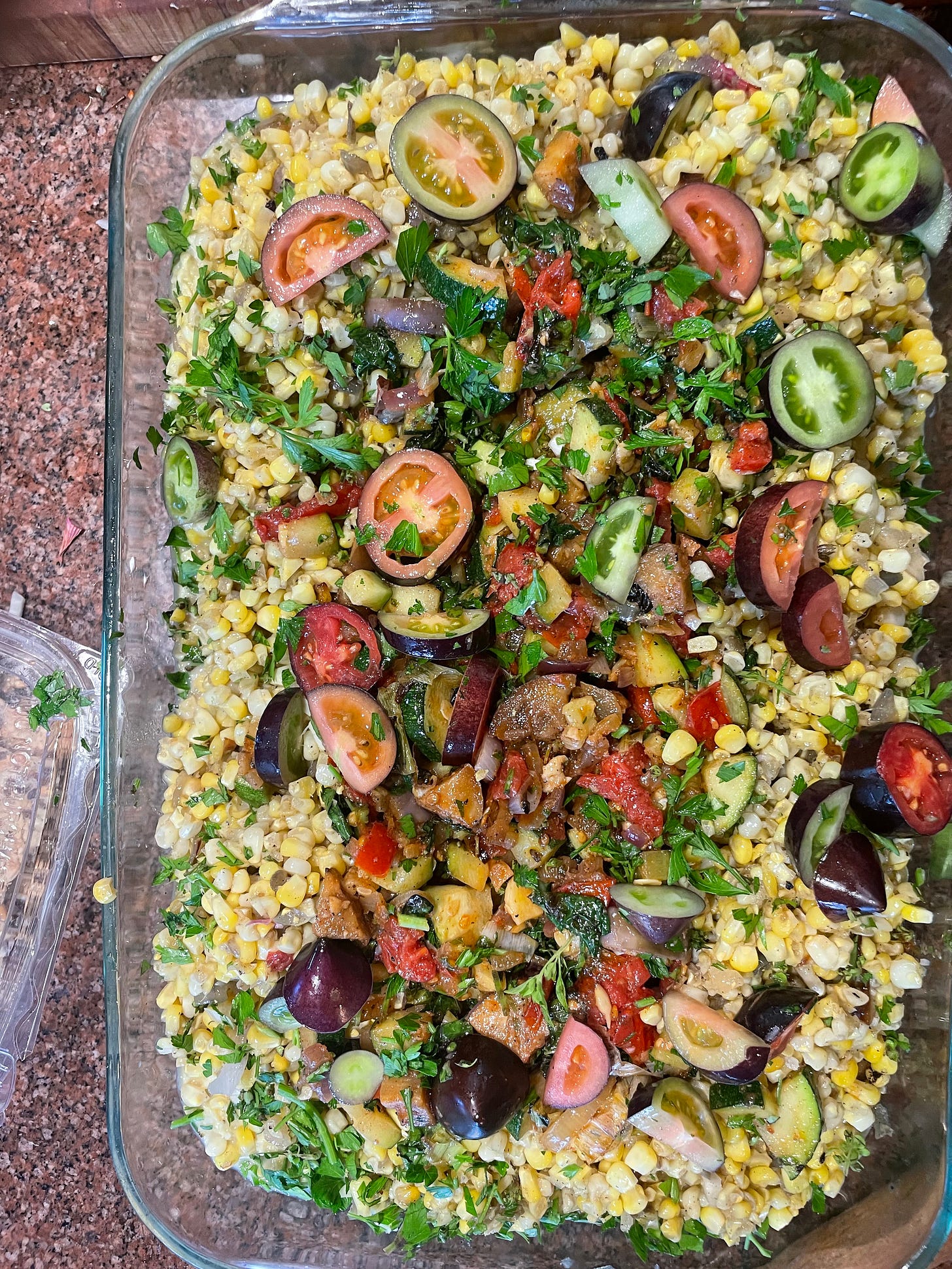Corn: From Detasseling to Table
A cornfield just a few miles from my house, not unlike the miles of cornfields of the Midwest.
When I was a teenager, I briefly worked as a corn detasseler, trudging through hot, sticky, itchy fields that seemed to stretch on forever. Back then, corn was just part of the backdrop of my life. Only later did I realize how those endless rows would become central to one of the biggest battles in our food system: GMO dominance versus organic farming.
Detasseling involved stripping the tassels from female rows of seed corn to prevent self-pollination, leaving male rows intact to provide pollen. Corn, along with soybeans, wheat, and oats, filled the landscape of my upbringing.
I visit the Chicagoland/Wisconsin corridor three to four times a year to see my 93-year-old dad and other family members, who still live in the area. I am fascinated by the remaining silos and the open land. Much has changed, yet it’s still the Midwest, with corn and soybean fields. Most dairy farms are now CAFOs (Concentrated Animal Feeding Operations), which describe the life of cows that never see daylight and spend their days eating mostly GMO corn. I am reminded that modern farming techniques have brought efficiency but also created challenges for health and well-being. Many of the fields I remember have become new villages with post offices and suburban sprawl. Where corn remains, corporate signs dominate: Pioneer, Monsanto, Syngenta, Becks, Agrigold. Most of these fields are planted with genetically modified Bt corn, engineered to resist insects like the European corn borer.
GMO Corn
GMO corn is not easy to identify. You must ask.
To be fair, not all advances in corn genetics are bad. Sweet corn is a perfect example. Years ago, an ear of corn lost its sweetness almost immediately after being picked, turning starchy and bland. Modern plant breeding has changed that, making fresh, flavorful corn more accessible. I remember my dad telling my mother to have a pot of salted water boiling by the time he got home with freshly picked corn from the farm—because we only ate it fresh. The rest of the time, it was canned corn. This is what genetics can do when it serves the eater.
The story of GMO corn—the kind dominating the Midwest—is about chemical agriculture, not taste or nutrition. Bt corn, widely promoted as insect-resistant, was once hailed as a solution to pest problems. Yet its overuse is causing more harm than good. Insects are evolving resistance to Bt, forcing farmers to rely on additional chemicals.
The toxins from Bt corn often enter nearby streams and other bodies of water through runoff. These toxins increase death rates and stunt the growth of caddisflies and other aquatic insects closely related to the pests Bt corn is designed to target. They also damage butterflies and other pollinators, further disrupting ecosystems. Pesticide use has climbed, biodiversity has declined, and soil and water health have suffered. For organic farmers, these factors make challenges like pollen drift, contamination, and limited access to certified organic seed even more difficult.
Respect for Farmers’ Labor
It’s not just genetics or chemicals that threaten corn farming. I’ve seen firsthand how little some people appreciate the work it takes to grow an ear of corn. Customers strip corn, disregarding “Do Not Strip the Corn” signs. I often wonder: what are they looking for—a worm? Rot? A tiny flaw in a $2 ear of corn? If it’s good enough for the worm, it is good enough for me. Each damaged ear represents countless hours of labor, care, and attention.
I remember talking years ago with Simon Athern, a farmer at Morning Glory Farm on Martha’s Vineyard, about the challenges of raising corn: securing organic corn seed, battling pests, and dealing with raccoons raiding the fields at night—nature’s uninvited guests. Not much different from customers who strip, inspect, and toss back without understanding the work it takes to grow a kernel into a whole ear.
Farmers Leading the Way
When I travel the roads between Chicagoland and Wisconsin, I look for those who are doing good work—and they are out there. Across the Midwest, farmers like the Hughes family in Janesville, Wisconsin, and Doug Rebout & Sons are proving that sustainable, organic corn farming is possible. c has cultivated specialty blue corn for over 175 years, growing crops like lima beans, snap beans, and kernza, and turning blue corn into products such as tortilla chips.
These are the farmers I want to support. They prioritize soil health, biodiversity, and long-term stewardship over short-term yields. Many also develop shelf-stable or value-added products, which diversify revenue, expand markets, and reduce waste. Seeing these efforts gives me hope in landscapes often lost to industrial agriculture.
Why Organic Corn Matters
It’s easy to say, “It’s only corn,” or “We don’t eat it that often,” but the truth is the fight for organic corn is about more than a niche market. It safeguards ecosystems, protects soil and water, and sustains local communities. Every purchase of organic corn, every farmers’ market visit, every conversation with a grower helps preserve this alternative system.
The cornfields of my childhood taught me about labor, land, and community. Today, they remind me of what’s at stake. Corn can either nourish people and communities—or lock us deeper into chemical dependence and disregard for farmers’ labor.
What You Can Do
Buy organic corn whenever possible.
PLEASE don’t strip the corn!
Support policies that protect organic seed and prevent GMO contamination.
Speak out about the overuse of Bt corn and industrial pesticide practices that harm pollinators, aquatic life, and ecosystems.
Every choice matters. Each ear of organic corn you honor is a vote for a sustainable, ethical, and nourishing food system.
Creamy Corn & Summer Harvest Recipe
Celebrate the harvest while honoring the farmers who make it possible! This recipe turns half the corn into a creamy puree and sprinkles the rest on top for texture—perfect for using ears that aren’t perfectly fresh.
And one more tip from my catering days: lime zest and chives brighten corn beautifully, whether you zest lime butter and chives on hot corn or add them to corn salad….
Ingredients
6 ears of corn
¼ cup olive oil (plus extra for cooking vegetables)
1 medium zucchini, cut into small pieces
1 Japanese eggplant, sliced into rounds (cut in half if large)
3 shallots, minced
2 cloves garlic, minced
8 cherry tomatoes, halved
6 fresh basil leaves, chopped
Salt and pepper, to taste
Prepare the Corn:
Shuck the corn and remove the silk.
Stand each ear upright on a cutting board and shave off the kernels with a sharp knife. Separate the kernels into two portions: one portion for pureeing, one for sprinkling on top.
Make the Creamy Corn Base:
Heat a skillet over medium heat and add 2 tablespoons olive oil.
Sauté ⅓ of the shallots until soft.
Add half of the corn kernels and cook just until they brighten in color (1–2 minutes).
Transfer to a food processor, add 2 basil leaves, and puree until smooth.
Spread this creamy corn mixture evenly on the bottom of a shallow serving bowl.
Cook the Vegetables:
Eggplant: Heat 3–4 tablespoons olive oil in a skillet. Add the eggplant slices, spread evenly, and cook a few minutes until soft. Add ⅓ of the shallots, half the garlic, and ½ teaspoon salt. Cook through, turning occasionally. Transfer to a bowl.
Zucchini: In the same skillet, cook zucchini until bright green and slightly crisp. Add to the eggplant.
Tomatoes: Lightly warm the cherry tomato halves in the skillet; they should be just heated, not fully cooked. Toss with remaining basil.
Cook Remaining Corn Kernels:
Heat a bit of olive oil in a skillet, sauté the remaining shallots and garlic briefly.
Add the remaining corn kernels, season with salt and pepper, and cook just until heated through (about 1 minute).
Assemble the Dish:
Spread the zucchini and eggplant mixture in the center of the creamy corn base.
Arrange the warmed tomato halves on top.
Sprinkle the cooked corn kernels around the edges for texture.
Serve warm or at room temperature. Enjoy the bright flavors of the garden.
Top the dish with slices of fresh tomatoes for more flavor and texture.






